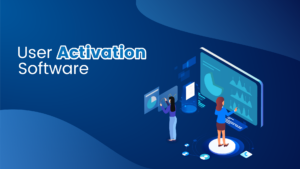
A Definitive Guide on User Activation Software in 2023
Welcome to the world of user activation software, where the secret sauce to unlocking the full potential of your product or service lies. In this
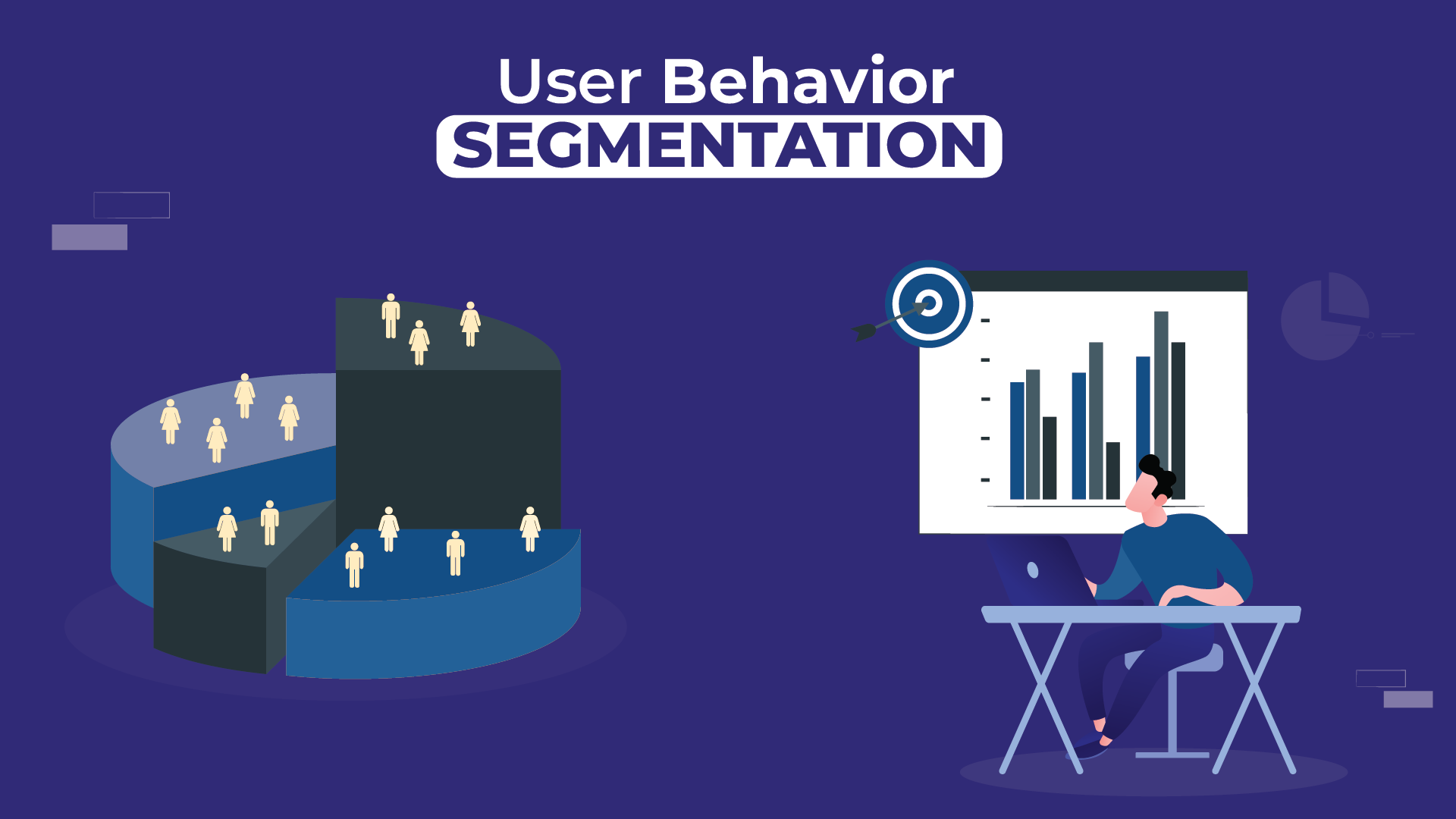
Ever wondered how often customers visit your online store before making a purchase? Or which promotional messages drive higher-value sales? User behavior segmentation holds the key to these vital insights, empowering you to tailor campaigns with precision and achieve remarkable results.
Not only does behavioral segmentation deliver impressive outcomes, but segmented campaigns also enjoy a 10.64% higher open rate compared to unsegmented ones. Curious to learn more about this powerful strategy and its benefits for your business?
You’ve come to the right place. In this article, you’re about to explore customer behavior segmentation, its advantages, and real-life case studies to illustrate its success. So, let’s get started!
User behavior segmentation is the process of categorizing customers based on their actions and interactions with a company. It goes beyond demographics and looks at what customers do, helping businesses tailor their offerings to meet specific needs.
Behavioral segmentation complements other factors like demographics and helps in developing smart marketing strategies. It enables businesses to address specific customer needs, quantify their value, and execute successful campaigns.
Understanding the behaviors and preferences of your target audience opens up a world of opportunities. Let’s talk about the benefits of user behavior segmentation and why a business should care about it.
Segmenting customers based on behavior allows you to create targeted marketing campaigns that address each group’s specific needs and preferences. This personalized approach allows you to create precise marketing campaigns that resonate with each segment, therefore increasing the chances of engagement and conversion.
Businesses that understand customer behavior can allocate their resources more effectively. Hence, instead of wasting time and money on customers who are unlikely to buy, you can concentrate your focus on engaged and loyal customers who are more likely to purchase again.
Customer behavioral segmentation allows marketers to understand the interests and preferences of each group. Using this insight, you can craft more relevant and compelling messages that resonate with your customers.
It eventually helps to capture the attention of the audience and increase the chances of them taking the desired action, whether it’s making a purchase, signing up for a service, or engaging with the brand.
According to research,
74% of respondents value feeling appreciated and understood over special offers for brand loyalty. Additionally, 64% of consumers are ready to pay more for a brand that remembers them and offers them a personalized experience.
There! You’ve already known the importance of user behavior segmentation for brand loyalty. When customers feel understood and valued, they are more likely to remain loyal, become brand advocates, and attract new customers through positive word-of-mouth.
Behavioral segmentation gives you measurable data and insights into customer behavior within each segment. You can track and analyze this data to identify trends, predict customer needs, and make wise decisions for future marketing efforts.
Let’s explore different types of examples of behavioral segmentation and how they drive engagement and conversions.
This segmentation categorizes users based on their likelihood of buying, purchase frequency, and buying considerations. Businesses can customize offers and predict future purchases by analyzing factors such as the elapsed time since the last purchase or different buying considerations.
User satisfaction segmentation separates people into categories based on how satisfied they are with the products or services. You can measure this using NPS scores, surveys, reviews, and sentiment analysis. This segment can be utilized for targeted marketing, loyalty programs, and overall customer experience enhancement.
This segmentation categorizes customers who are likely to interact with the brand or make purchases based on specific occasions or set times. It can include national holidays, seasonal events, or daily routines. Understanding occasion-based behavior helps you plan targeted marketing campaigns.
Customer engagement segmentation categorizes customers based on their level of interaction: occasional, regular, and intensive. Occasionals lack motivation or trust, while regulars need encouragement to explore more. Intensives are loyal and benefit from rewards. Tailoring marketing strategies to each level improves retention and drives success.
Segmenting users based on loyalty allows you to target repeat customers and gain insights into what motivates their loyalty. This segmentation considers factors such as purchase frequency, engagement levels, and participation in loyalty programs. Loyal customers are considered highly valuable as they are more likely to stick with the brand, require lower retention costs, and serve as brand ambassadors.
Benefits sought segmentation helps businesses understand customers’ motivations and tailor messaging accordingly. By identifying the primary benefits customers value, you can optimize your offerings and show your customers why they should choose your products over competitors. This segmentation considers types of benefits like quality, price, reviews, and unique selling points.
Segmenting users based on their journey phases, like awareness, consideration, decision, retention, and advocacy, enables businesses to tailor communications and experiences at each stage. You can take steps to remove the friction points and improve conversions by identifying customers who haven’t progressed through the journey.
Segmenting users based on their current relationship with the business provides a different perspective. User status behavioral segmentation includes free users, trial users, basic users, pro users, and churned users. You can combine user status segmentation with other approaches to identify trends within different user subgroups.
This segmentation is based on customer interests derived from their behavioral data, such as website page views, email clicks, or purchase history. Understanding customers’ interests allows you to personalize marketing messages, recommend relevant products, and create targeted content.
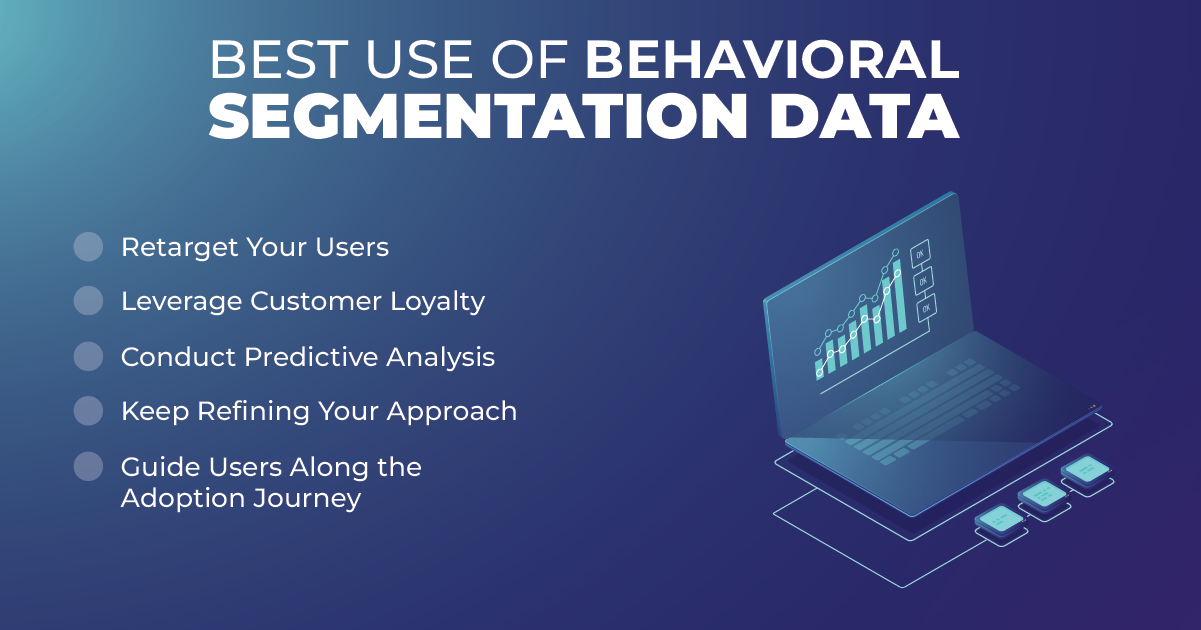
Implementing user behavior segmentation in your business can significantly enhance your marketing strategies and boost customer engagement. Here are some best practices to make the most use of behavioral segmentation data:
Focus on existing users to increase their lifetime value. Use retargeting techniques in your marketing campaigns to re-engage previous users and encourage them to upgrade or renew their subscriptions.
Use behavioral segmentation to identify their usage patterns and preferences, such as specific features they frequently use or integrations they prefer. Tailor your messaging and offers accordingly to remind them of the value they can gain by continuing their subscription.
Analyze behavioral data to understand the pain points and desired outcomes of different user segments. Guide your users to overcome these roadblocks by offering step-by-step tutorials, case studies, and access to customer success resources to ensure a smooth adoption process.
Suppose you operate a software company offering productivity tools. Encourage customers to upgrade from the basic free version to the premium version by sending personalized emails that highlight the advanced features and how they address specific pain points of each customer segment, such as project management or data analysis.
Identify your most loyal customers and understand why they continue to choose your brand. For example, if you offer a project management tool, identify the specific project management challenges your customers face and create educational resources like tutorials and best practices guides to address them.
You can increase repeat purchases and maximize ROI by focusing on consumers’ most frequent issues and highlighting your solution.
You can construct predictive models and uncover insights into future trends and behaviors by using behavioral data. This understanding of patterns and ability to forecast future actions empowers you to make informed decisions, fine-tune your strategies, and provide exceptional experiences to your customers.
Furthermore, it positions you a step ahead of the competition, ensuring you stay proactive and responsive in meeting constantly changing market demands.
Regularly analyze and update your behavioral segmentation approach. As customer behaviors and preferences evolve, adapt your segmentation strategy to ensure its relevance and effectiveness. Stay agile and responsive to changes in the market and customer dynamics.
These companies effectively utilized user behavior segmentation to understand their consumers’ behavior and drive product success:
As the most valuable soft drink company globally, Coca-Cola focuses on consumer behavior to refine its segmentation strategy. They analyze website analytics, social media data, and loyalty status to understand customer preferences.
Coca-Cola tailors its products, content, and messages by identifying popular occasions and benefits sought by consumers, such as a refreshing taste or brand vibe. This approach has solidified its position as an unrivaled market leader with a loyal customer base.
Olay, a global skincare brand, used artificial intelligence in its Skin Advisor tool to gather valuable customer data, gain insights into behavior, and provide personalized advice.
Utilizing this data, Olay introduced new product options like fragrance-free variants and Retinol 24. This strategic approach not only boosted revenue but also empowered Olay to shape customer behavior and deliver customized products.
This section wouldn’t be complete without Netflix, right? With more than 232.5 million paid subscribers, Netflix still dominates as the most subscribed video streaming service, and they are one of the most successful behavioral marketing examples too.
Netflix employs an algorithm that conducts A/B tests and experiments with viewer preferences. This algorithm influences everything from homepage layout to recommended content, including personalized visuals based on user preferences.
This data-driven approach enables Netflix to enhance user experiences, create loyal customers, and maximize lifetime value.
Congratulations! You now have a clear understanding of user behavior segmentation, its incredible benefits, and how to implement it in your business.
Understanding customer behavior allows you to maximize performance across multiple platforms while also tailoring your messaging and brand. Leveraging these insights, you can send the right messages to the right customers at the perfect time.
So, why wait? Harness the power of behavioral segmentation and empower your business to craft personalized strategies, forge deep connections, and thrive in today’s ever-evolving marketplace.
User segmentation is the process of categorizing users into distinct groups based on shared characteristics such as language preferences, product versions, geographical regions, or user personas. This segmentation enables product teams to analyze user behaviors across segments and create personalized experiences for each group.
Usage rate segmentation involves categorizing customers into distinct groups based on their level of product usage. This approach enables them to identify the specific features that different user segments prefer or dislike, empowering them to prioritize and refine features accordingly.
User status segmentation involves categorizing users based on their relationship with and commitment to a product. Here are examples of four types of user status segmentation:
Behavioral segmentation and psychographic segmentation are two distinct approaches used to understand consumer behavior and preferences. While both methods aim to divide customers into meaningful groups, they focus on different aspects and factors.
Behavioral segmentation focuses on how customers interact with products and brands. It considers factors like purchasing habits, brand loyalty, and interactions. This helps tailor marketing efforts to meet specific needs.
Psychographic segmentation goes beyond behavior to understand customers’ personalities, interests, values, beliefs, and lifestyles. It creates personalized experiences and connects on a deeper level.
In a nutshell, behavioral segmentation looks at actions, while psychographic segmentation considers individuals as people. By utilizing both, you gain insights to shape strategies and build meaningful connections with customers.

Welcome to the world of user activation software, where the secret sauce to unlocking the full potential of your product or service lies. In this
Have you ever wondered how businesses track user actions on their websites or apps? How do they measure the success of their marketing campaigns and
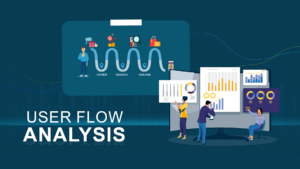
Have you ever wondered how users navigate through websites or apps? How do they seamlessly move from one screen to another, making decisions and accomplishing
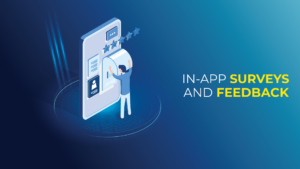
Do you want to create a product that truly speaks to your customers? Are you looking for ways to gather valuable feedback and improve the
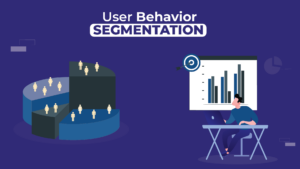
Ever wondered how often customers visit your online store before making a purchase? Or which promotional messages drive higher-value sales? User behavior segmentation holds the

In a world where data reigns supreme and competition is fierce, businesses are constantly searching for that extra edge that propels them ahead. Enter the